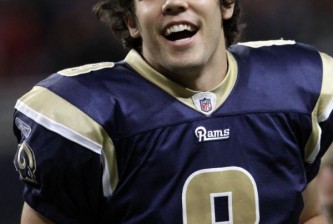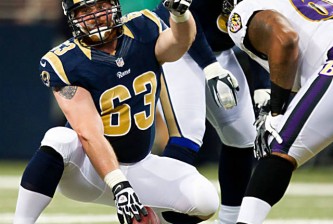
We’re just a few days away from the first open Rams practice of the season, which has become a bit of an event for local fans. Sort of like the swallows returning to Capistrano, it isn’t in and of itself a very unusual event — football players practice, we get it — but it heralds the opening of a new season. So we go, smartphones and water bottles in hand, to watch the proceedings with a sniper’s eyes, hoping to find elements of significance to latch our hopes onto.
I love practice observations — particularly in the Twitter-enabled world where you can get a firehose of chatter going from a dozen or more enthusiastic spotters — but they’re ultimately not nearly as revealing as we want them to be. A player that excels in practice (ahem Brandon Gibson) or in the preseason (hello Lance Kendricks) isn’t necessarily guaranteed of translating that excellence into the regular season.
We know this, but at the same time there are always subtle indicators that show up in practice that do echo into regular season play. With that in mind, here are three things that we should be able to see in practice that should be significant in terms of the season to come.
#1: Sam Bradford’s time to release.
NFL Films guru Greg Cosell analyzed Sam Bradford’s puzzling 2011 decline and highlighted a critical factor: “Bradford was tentative in the pocket, not mentally sharp, and at times he did not let it loose when he had a throw.”
We didn’t know it at the time, but this was evident in the Rams’ practices as well. Whereas his play under Pat Shurmur was predicated on making quick reads and throwing darts, under Josh McDaniels he seemed more content to float back and watch routes unfurl. It wasn’t uncommon for a play to evolve for four, five or six seconds in practice before Bradford made a throw. Often, it was a beauty of a throw, and we were so wrapped up (then as now) in the wide receiver competition that we were more focused on the catch (or non-catch) to notice that in a real game, without the red jersey, he would have been spread out like fertilizer on the grass.
A return to a West-Coast-based offense should mean a return to decisions made on pre-snap reads and quick throws (two seconds or less from the snap), rather than waiting on combo routes and one-on-one battles to unfold.
#2: Robert Quinn vs Rodger Saffold
One of the true highlights of camp is watching the linemen square off against each other in pass rush / pass protection drills. Whenever those start, I turn away from whatever else is going on and hustle over there to watch.
Three years ago, watching Chris Long engage in these drills was painful. He was so easily swallowed up in his bull rush, and so frustrated at being contained by savvier players like Adam Goldberg. One year later, though, he looked like a different man. He had a far more refined rip move, and his first step seemed lightning fast. He ate up whoever was trying to guard him, and it paid off in a breakthrough 8 1/2 sack season (with a league-leading 57 hurries) that put him back on the map as a pass-rushing force.
This year, with so much talent on the defensive side of the ball and such uncertainty on the offensive side, there will be a lot at stake in these battles. Saffold needs to show significant improvement, especially on inside moves – something that Quinn is naturally gifted at. We want to see Quinn become more fully realized as well, showing more consistent motor and more strength to go along with his speed.
#3: Who’s being vocal?
The leadership on field can be seen in practice, although it’s easier to see when those leaders are being vocal and animated. Chris Long and James Laurinaitis were the obvious captains on defense, and helped ensure that the team never quit on the 2011 season despite the piles of demoralizing losses (of games and teammates).
However, Steven Jackson and Sam Bradford both tend toward “quiet” leadership … Bradford especially. Part of this is a factor of how they spend their “down” time — Bradford rarely spent a minute on the sideline without McDaniels or a backup QB in his ear. The offensive line also felt captain-less. It will be interesting to see whether Harvey Dahl (reunited with offensive line coach Paul Boudreau) or veteran center Scott Wells (and his Packers Super Bowl ring) take audible and visible charge of their unit.
One player whose voice will be missed, at least from a fan’s perspective, is Mardy Gilyard. He may not be quite NFL caliber as a wideout, but he’s got a Hall of Fame level of swagger. No doubt our ears will be tuned to Janoris Jenkins, Cortland Finnegan and Brian Quick to fill that void.






















